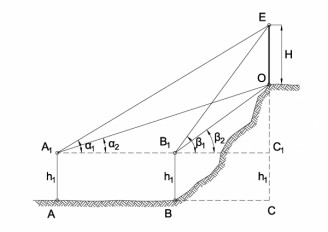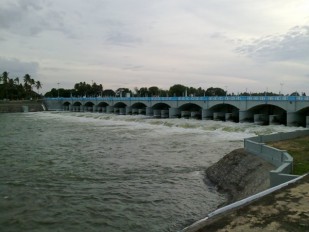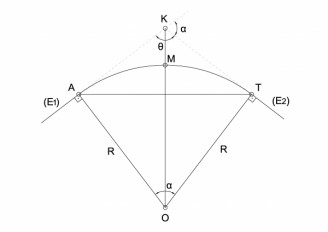
Contents [show]
Determine the coordinates of an unknown point M (impossible to occupy) visible from two (2) previously surveyed reference stations A, B of a control baseline, only by observing angles α and β subtended by lines of sight from stations A and B to the intersected point M. Intersection technique is commonly implemented when the unknown point to be observed is inaccessible during a survey.
Known values: Angles a and b (observed), Reference stations' A, B coordinates.
Solution: Point M coordinates.
Adopting the clockwise lettering sequence, the coordinates of point M can be obtained directly from:
For maximum accuracy in the calculation of point M coordinates, the angle of intersection of lines of sight AM and BM must be between 60° and 120°.
Selected Topics
Want to read more like this?

Calculation example - Three Point Resection
Apr, 23, 2017 | EducationDetermine the coordinates of an unknown station P from three (3) previously coordinated reference po...

Calculation example - Find the coordinates of the intersection of two lines
Jan, 20, 2020 | EducationCalculate the coordinates of the intersection of two lines given their bearings from two known stati...

Calculation example – Re-establishing an inaccessible Reference Station
Jan, 16, 2019 | EducationRe-establish the reference station T (inaccessible by the surveyor) onto position B and calculate th...

Calculation example – Re-establishing an accessible Reference Station
Sep, 22, 2017 | EducationRe-establish the reference station T (accessible by the surveyor) onto position B and calculate the...

Calculation example – Similarity Transformation in 2-D space
Sep, 22, 2017 | EducationCalculate the coordinates of a known point P in an orthogonal coordinate system to a reference ortho...

Calculation example – Indirect length measurement with basic trigonometry
Sep, 22, 2017 | EducationDetermine the length between two points A and B by measuring two side lengths from a third occupied...

Calculation example - Resections
Oct, 18, 2019 | EducationCalculate the coordinates of a distant point Tn, referencing measured angles and coordinates of four...

Calculation example - Find the coordinates of the intersection of two lines
Jan, 20, 2020 | EducationCalculate the coordinates of the intersection of two lines given the coordinates of four stations....

Calculation example - Calculate the height of an object when its top and bottom are visible but inaccessible
Jun, 26, 2019 | EducationCalculate the height of an object from a baseline when its top and bottom is visible but not accessi...
Trending

Calculation example - Determine the water content within a soil sample

Gauss's Area Calculation Formula

The history of the Golden Gate Bridge

Kallanai Dam (Grand Anicut)

Calculation example – Road design– Circular arc implementation

Minoan Water Harvesting and Distribution (Terracotta Pipes)

Calculation example – Calculate the height of a building

